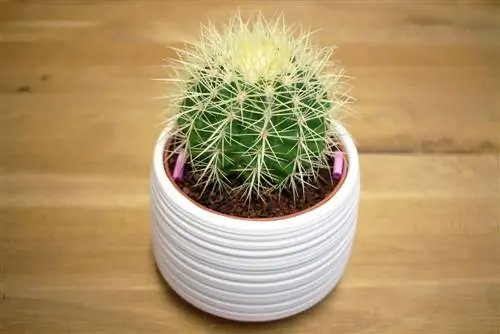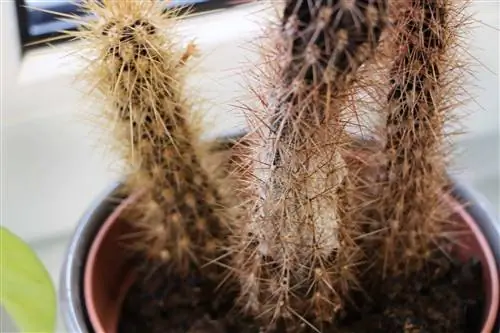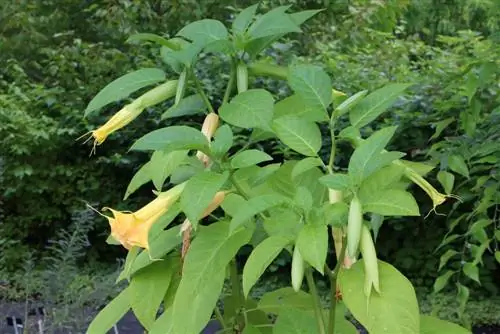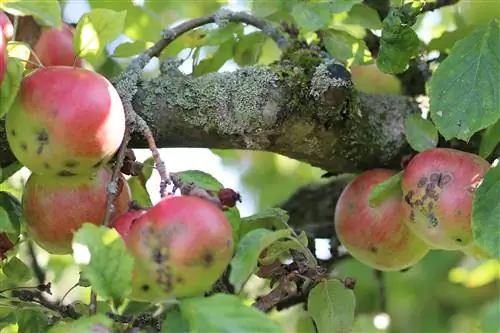- Author admin [email protected].
- Public 2023-12-17 03:39.
- Last modified 2025-06-01 06:48.
Cacti are naturally robust against diseases and pests. If they do fall ill or become infected, the cause is often a mistake in care. For this reason, damage can usually be easily prevented if a few points are taken into account.
Tiny small or expansive - cacti come in many forms. What they all have in common is their high level of resistance. However, diseases or pests can still occur on them. However, with the right care, infestations can usually be prevented. And if the cacti do become ill, the appropriate measures can quickly provide relief. Of course, this requires the appropriate knowledge to make quick and targeted intervention possible.
Prevent infections and infestations
Cacti are fundamentally he althy and resilient plants that are generally not very susceptible to diseases and pests. The already strong immune system of succulents can be further boosted. It is ideal to give the cacti an outdoor space in summer. Unfiltered sunlight, rain and fresh air harden the plants. As do the temperature differences between day and night. A cooler winter quarters - which should of course be adapted to the respective cactus species - gives the plants the necessary rest period. This also makes it possible for the plants to better defend themselves against pathogens.
Errors in care
Many diseases and even pest infestations can be traced back to errors in cactus care. Probably the most common - albeit well-intentioned - mistake can be found in the casting. Since the cactus is optimally adapted to dryness, it cannot release too much moisture into the environment or can only release it to a very small extent. This causes it to build up in the substrate and the plant itself, which leads to rot and weakens the plant overall. Plant parts can also burst. If the culture or location is not optimal, other typical symptoms appear. Below:
- yellowish discoloration and soft plant parts
- reddish discoloration
- thin, weak and light shoots
- premature dropping of buds
If the cactus turns yellow and wrinkled, there are two possible reasons. The possibility of frost damage is limited to the cold season. If the plant is moved to a frost-free location, the damage will at least not be increased. However, complete recovery is not guaranteed either. There can be an oversupply of water all year round, which can also be caused by rain, for example. Changing the substrate and keeping it drier in the future can still save the cactus.
If cacti turn reddish, it is sunburn - protection from the blazing sun is sufficient as a measure. If the shoots appear weak and are noticeably light and thin, the reason can also be found in the light and water. The cacti are usually too dark, too warm and too moist. If some buds fall off, this is no reason to worry about the cactus. Many species simply produce more than will actually bloom. However, if there are larger numbers, the conditions at the location should be checked - too little light, heat and water are possible causes. Once buds have appeared, the cactus may no longer be turned.
Diseases

The possible diseases of cacti are rarely of a bacterial or viral nature. If this is an infection, affected plants show growths and reduced growth. If only small areas are affected, the possible solution is to remove the diseased parts. To do this, a sharp, disinfected knife is used to generously cut off anything that does not appear he althy. Both interfaces and used tools are then disinfected again. Suitable agents are hydrogen peroxide and potassium permanganate. Fungi occur on cacti much more frequently than viruses and bacteria. These always have an easy time when the cactus is too moist. Below:
- Epiphyllum Mosaic Disease
- Focal spot disease
- Stem rot (Helminthosporum)
- Root rot or stem rot (Phytophthora)
- Black sooty mold
- Rhizoctonia rot
- Phythium rot
Epiphyllum Mosaic Disease
Epiphyllum mosaic disease is considered one of the most common fungal infections in cacti and, unfortunately, is hardly curable. The most obvious symptom are yellowish, light spots that visibly sink in. The cactus should first be isolated so as not to infect other plants. A tentative cure is possible but not likely by removing the affected areas and then disinfecting them.
Focal spot disease
As the name suggests, focal spot disease on cactus manifests itself through brownish spots that appear burnt. The areas become hard and sometimes cracked. The first treatment should be to cut them out with a sharp knife and dust the open areas with activated charcoal. If this is not successful, a fungicide must be used.
Stem rot (Helminthosporum)
Stem rot usually penetrates the plant through injuries; the pathogens come from the substrate. Affected areas become soft and glassy. If you cut above the infected area and change the substrate, at least the head of the succulent can be saved.
Root rot or stem rot (Phytophthora)
The cactus rots from bottom to top. The treatment is the same as for stem rot.
Black sooty mold
The name already reveals the appearance of the sooty mold fungus, as it manifests itself as a black coating. It can easily be treated with fungicides on cacti.
Rhizoctonia rot
Rhizoctonia rot is noticeable through a white fungal coating on the cactus and substrate. Affected plant sections appear glassy and soft or even slimy. If the infestation is small, fungicides help; if the infection is severe, he althy sections of the cacti can be removed, disinfected and replanted.
Pythium rot
Pythium rot is a typical stress disease that affects cacti with weakened immune systems. It also manifests itself through white deposits - but its appearance can take many forms. Removal of the affected areas and treatment with fungicide can help.
Pests
The list of possible pests on cacti is long, but in reality they only occur rarely. They include:
- Snails
- Mice
- little or nematodes
- various lice, such as aphids, scale insects, mealybugs and mealybugs
- Sad gnats
- Spider mites
- Whitefly
Snails and Mice
The damage caused by these animals can be quickly recognized by the large feeding marks. In both cases, an elevated location that cannot be reached by mice or snails helps.
little or nematodes
The nematodes or nematodes are roundworms that often serve as beneficial insects in the garden. These uninvited guests usually cause misshapen growths and limited discoloration on the cacti. A rescue attempt can be started if the infestation is still small. To do this, the substrate must be changed thoroughly and the growths removed.
Lice
Lice are easy to recognize on cacti, regardless of their species. Outdoors, the best control is to use ladybirds, lacewings or parasitic wasps. Yellow tablets and insecticides also help.
Sad gnats
Sickness gnats are actually flies that are black in color and small. They lay their eggs in the substrate and are quite easy to combat with a little patience. Glue traps and changing the substrate are usually sufficient.
Spider mites
Spider mites can attack the cactus, especially if it is in dry, heated air. To get rid of them, the cacti are showered or sprayed well with water and packed in an airtight bag for two to three days. The warm, humid climate doesn't get the mites.
Whitefly
Once whiteflies have established themselves, they can rise as a whole swarm - this is immediately noticeable when watering. Yellow plates, a change of substrate and the use of wasps or parasitic wasps are suitable for combating it. As well as ventilation, because these pests prefer a very humid and warm climate, but dryness and cool fresh air drive them away.
Frequently asked questions
How do I prevent infection between my cacti?
Contracting diseases or skipping them is quite common. This can be avoided if the plants are not too close to each other. Sick cacti must be isolated immediately. In addition, all scissors, knives, pots and other tools must be thoroughly disinfected after each use.
Can I introduce diseases and pests?
No matter how beautiful a new cactus is, it always poses a danger to the existing plants. Infestations cannot always be recognized immediately, which is why every new purchase is quarantined for three to four weeks an isolated location - should be moved.
What you need to know about care
If you want to care for cacti properly, you have to take a lot of things into account. Although the prickly plants, which belong to the succulite family, are quite undemanding, they thank the owner for appropriate care with good growth and, depending on the species, also with unusual flowers. In general, it can be said that the most important factors for cacti to thrive are light, soil and water. Some interesting cacti and succulents: carrion flower, aloe vera, bishop's hat, prickly pear, Christmas cactus.
- All cacti should be very bright. The windowsill is best suited to a window where the sun shines strongly.
- But cacti also do well outside, at least in the summer months.
- However, they must be protected from periods of bad weather with a lot of rain.
- If there is too much moisture, the cacti can die quickly.
- If the cacti are to be housed in the greenhouse, it is important that it has sufficient ventilation options.
- Otherwise, extreme temperatures will occur here, which are not necessarily beneficial for cacti that are used to heat.
So-called horniness often occurs. This means that the cacti develop extremely thin and long shoots, which are not only unsightly to look at but can also be harmful to the he alth of the plant. Any cactus will die in the middle of the room or even on a shelf because there is far too little light here. Such places should therefore be avoided. If you are unsure, you can also use special light meters to measure the lighting conditions at your expected location. This way you can quickly find out whether it is suitable or not. But the soil in which cacti are planted is also crucial:
- So you should mix garden soil with permeable layers such as sand, gravel or potsherds.
- It is important that the earth does not make up too large a part and that the soil is very permeable to air and water.
- You can also use commercially available cactus soil, but mixing it with sand or gravel is much more recommended.
When watering, you have to be careful not to overdo it. After all, how many cacti have been truly drowned by overprotective flower lovers? Of course, you should know that waterlogging is fatal for cacti. This causes the roots to rot and the rot quickly spreads across the entire plant. It is then irretrievably lost. In general, it is best not to water cacti in winter.
Cacti are naturally robust against diseases and pests. If they do fall ill or become infected, the cause is often a mistake in care. For this reason, damage can usually be easily prevented if a few points are taken into account.






